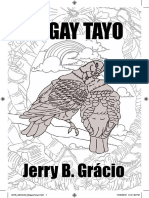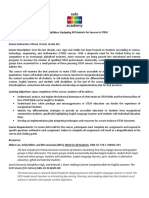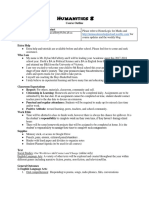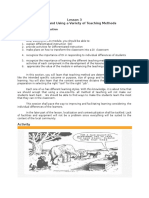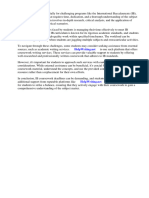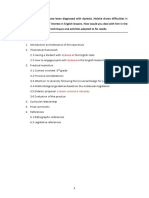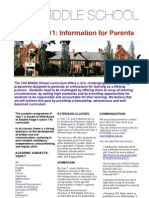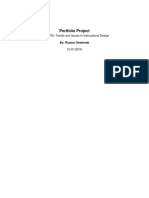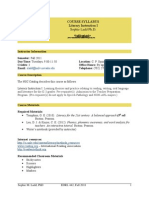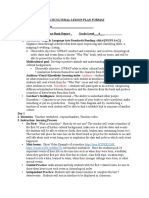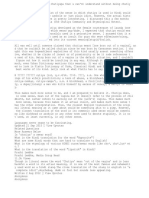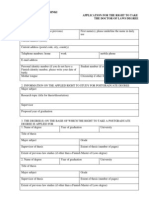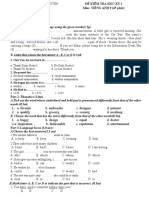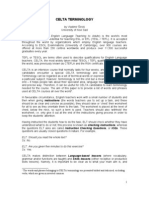Sequential Teaching and Learning Complete
Sequential Teaching and Learning Complete
Uploaded by
api-114948504Copyright:
Available Formats
Sequential Teaching and Learning Complete
Sequential Teaching and Learning Complete
Uploaded by
api-114948504Original Title
Copyright
Available Formats
Share this document
Did you find this document useful?
Is this content inappropriate?
Copyright:
Available Formats
Sequential Teaching and Learning Complete
Sequential Teaching and Learning Complete
Uploaded by
api-114948504Copyright:
Available Formats
1 Analysis of a Sequence of Teaching and Learning Option 1: Part B
ANALYSIS OF A SEQUENCE OF TEACHING AND LEARNING
By Sasha Koomen
One: Select the sequence, the class group
Title of Unit of Work / Learning Sequence: Immigration: Creating a Family Story Class: Quest (integrated English/Humanities/Religion and ICT) This unit of work mainly focuses on English and ICT (also involving different aspects of History) Key content to be addressed:
Key
VELS English: reflect on and discuss contemporary and classical imaginative texts that explore personal, social, cultural and political issues of significance to their own lives (how did their families come to live in Australia?). VELS History: students analyse events which contributed to Australias social, political and cultural development in regards to immigration. Research the family history dealing with complex ideas and issues Conduct and record an interview with a family member Collect information at the Immigration Museum Decide on the format of the digital Family Story Create a memory story Present a suitcase of 6 artefacts Experiment with chronology, characterization, consistent point of view and development of resolution Breakdown of different narrative texts (i.e. film, novel, picture book, Cuc Lams suitcase) skills to be addressed: Researching: Gathering of information (interviewing skills, internet) Planning and organization Text Structure: The way you tell your family story Using ICT: choosing a suitable digital format (Picture book, film, narrative, etc.) The quality of the presentation The technical requirements of the presentation The creativity of different stories and artifacts Knowledge of immigration in a particular era Correct Punctuation/Grammar and spelling Discussion and listening skills They select subject matter and begin to use a range of language techniques to try to position readers to accept
1
Sasha Koomen, Christian Brothers College, St Kilda East
2 Analysis of a Sequence of Teaching and Learning Option 1: Part B
particular views of people They plan and deliver presentations, sequencing and organising complex ideas. When engaged in discussion, they compare ideas, build on others ideas, provide and justify other points of view, and reach conclusions that take account of aspects of an issue. In their presentations, they make effective use of the structures and features of spoken language to deal with complex subject matter in a range of situations.
Two: Describe the factors that may influence your teaching Characteristics of the School: The school is located in St Kilda and because of its location has a very diverse multicultural and socio-economic mix of students, some coming from the housing commissions others coming from the upper class areas of metropolitan Melbourne. As the school has such a diverse range of students from different backgrounds, all families have different expectations from their children. CBC has a Year 9 campus located about 10 minute walk from the main campus, the year 9s have a very different and exciting integrated curriculum. The Year 9 educational program is based on VELS covering all of the different domains. The school holds high expectations for student learning, however as students are from a wide range of backgrounds, we also cater for the lower level students. Because of the different levels the teachers develop programs that provide multiple and creative opportunities for all of our students to learn, achieve, and reflect on their own learning in a supportive environment. Characteristics of the students that may affect their learning: My Quest class (Integrated English, Humanities, Religion and ICT) consists of 19 male students (aged between 14 and 15). The students reading levels range from 3.75 5.5 according to VELS standards. The students writing abilities are varied and their needs are scattered. Three of my students are still at a primary school level of writing, although a teaching aid occasionally comes into class to assist them with their work. These students have their English work modified and scaffold to their ability level. This is completed by using Individual Learning Plans for different students and meeting with the Learning Needs staff every week. There is a wide range of learning abilities presented and this was catered for in this assessment by giving the students the option to complete Cuc Lams story, or a modified Family Story option. Teaching challenges presented by the class or students: There are no substantial behavioral concerns within the classroom. However there are a couple of students who are easily distracted and can disturb the class, this is always addressed quickly using the rules the students created,
2 Sasha Koomen, Christian Brothers College, St Kilda East
3 Analysis of a Sequence of Teaching and Learning Option 1: Part B
and on occasions a student may be removed from class. Using ICT consistently in the classroom can be a slight issue, as students can sometimes be off task on their laptops. If this occurs the students give up their laptop for the rest of the lesson, and use their work books to complete the task. They then speak to me at the end of the lesson and a decision is made if they are responsible enough to use the netbook in class. Overall the students are managed using the positive learning plan which the students designed at the beginning of the year, if students are not taking responsibility for their learning they have a discussion with after class and sometimes Physical Learning Environment The classroom I teach my Quest class in is located at the Year 9 campus at Balaclava. The Year 9 centre is made up of four major classrooms and a Central area in which the whole year level often come together to watch guest speakers, community meetings and films on the giant projector. All the connecting walls in the Year 9 campus can be moved to make a giant interactive learning area, and two classes can be supervised or team taught quite easily. The classrooms also have high quality projectors, which are used in majority of the classes. The Learning Centre provides Year 9 students with an identifiable space in which to learn and exhibit their work. ICT access is excellent and includes an individual netbook for each student, five projectors, one interactive whiteboard and designated digital cameras and video flip cameras (these are used quite often in the English classes). The internet connection is generally very good, and there arent usually too many problems accessing online resources. My classroom is generally set up with tables in groups sitting four students, so that they can work in groups. It is easy to move the tables and chairs around and the Physical Learning area will change depending on the different activities the class is doing on the day. Other important factors: Students sometimes have problems accessing specific programs and internet sites on their netbook, however most of them are usually already on their netbooks. I sometimes lend my laptop to the students if they cannot access the program. Also sometimes the students netbooks can be blocked from using specific programs, this has been an issue in some of the classes in Semester one however we generally improvise and the classes go on without too many issues.
Three: Document your planning for the learning sequence or unit of work What should the students know (the content) and be able to do at the completion of the learning sequence of approximately 10 15
3 Sasha Koomen, Christian Brothers College, St Kilda East
4 Analysis of a Sequence of Teaching and Learning Option 1: Part B
hours? The students should be able to successfully tell their personal Family Immigration Story using a creative format, either digitally or creatively written. Be able to present an interesting an informative oral presentation about 6 artifacts the student have found which are relevant to the immigration story (or found images of online) Be able to research their own family story, by creating interview questions, researching on the internet and the Immigration museum for policies which may have affected their Appropriately structure their story, using tips given in the mentor texts lessons. Plan, Proofread and edit their work
What prior knowledge and/or skill do students need? Prior Knowledge Students should have a basic understanding of their family story, however this is not essential as they will soon learn more about it when they do their research and ask their families. Students already have quite a solid basis on how to write narratives and persuasive pieces as we have already completed two units of work on this in Semester One. Ability to use different web based and digital programs we have used throughout the year to present the story Skills Ability to research/write independently Ability to write interview questions and interview family members Ability to present their family story in a digital format (using one of the many programs we have used during the year) Ability to present an oral presentation What teaching and learning activities will enable the students to engage with and achieve the learning aims? Appendices A includes all the dates and planning of the lessons Guest speaker Mai Dinh to talk about her immigration story coming from Vietnam. This will happen at the beginning of the unit so that students understand that everyone has an immigration story and get an idea of what to include (students create questions to ask individually and as a class) Appendix B Mais Story Handout Discussion of how to conduct a proper formal interview. What are the relevant questions for this task? Proper interview advice Appendix C Interview Handout Think, Pair, Share: students share their family stories with their peers in a group activity Mentor Text Lesson (give students an idea of how they may want to
4 Sasha Koomen, Christian Brothers College, St Kilda East
5 Analysis of a Sequence of Teaching and Learning Option 1: Part B
present their family stories with the different mentor text lessons). Key passages from texts Set up stations in the classroom with a variety of media video clip, passages, podcast, photo, etc. 1. Cuc Lams suitcase 2. Nam Le The Boat 3. Memories book mentor text 4. Shaun Tan The Arrival , The Lost Thing Each teacher takes one of the mentor text lessons and presents it to the three classes. One class focuses on a specific story (in different formats) which looks at aspects of the story that could be used to create their own family story. Appendix D My mentor text lesson, what I presented to the students Guided mind map Popplet The students use a digital mindmap to take down notes on what aspects they will/will not use in their Family Story Program used for digital mindmap www.popplet.com The immigrants journey - arms include: the journey, challenges faced here, changes once here, symbolism used in the story, emotions, loss and gains, selections of words to convey meaning. Form essential questions in preparation for the Immigration Museum Appendix E Immigration Booklet Students travel to the Immigration Museum via train, they need to research policies and information about immigration at the time that may have impacted their family immigration story. Shared Writing (share ideas with peers and proof read each others work) Guided writing Class Discussion: Imagine and empathize what it might have been like in the time of the past, how will you express this emotion? Planning checklist to be completed Proofreading/Spelling and Punctuation Discussion on the perspective the story is coming from (first Person, third, autobiography) Outline of the Family Story Task students mainly work independently with guidance Appendix F Discussion and guidance on the type of program the students should use to present the Family Story Presentation of the 6 artifacts to the rest of the class Reflection on the students Digital Portfolios (Weebly) The teaching and learning activities will enable students to engage with and achieve their learning aims as they will:
5 Sasha Koomen, Christian Brothers College, St Kilda East
6 Analysis of a Sequence of Teaching and Learning Option 1: Part B
Students were able to see many different models of presenting stories through the mentor texts lesson with the expert teachers Stimulate and cater for a number of different learning styles and multiple intelligences (i.e. visual as they are using ICT for mind maps and presenting the story, linguistic they may choose to write creatively from different perspectives, interpersonal/intrapersonal speaking to the class and empathizing with their ancestors) Allow students the chance to present to their peers (presenting the 6 artifacts and their relevance o the class) Include guided, modeled and shared writing activities (modeled different writing in mentor texts, plenty of guidance from the teachers, but also help each other with their writing) Include oral presentations, which improves their interpersonal skills The students are able to explore outside the classroom setting and learn at the Immigration museum The learning activities are relevant, interesting and fun The overall project is very open-ended and is accessible to all students, they are able to push themselves and take themselves in any direction with the tasks (very inquiry based)
How will the learning environment need to be changed or organised differently throughout the unit of work, to assist student learning and safety, logistical and/or student management issues? No substantial changes will need to be made to the learning environment. When the Mai Dinh our guest speaker tells her family story to commence the unit, all students will need to sit in the central area (all four classes, 80 students) When the mentor text lessons are happening for the students, the classes will not move however the teachers will move to each of the four classes Students will need to travel to the Immigration museum with teachers on the train and do quite a lot of their research outside of school The class will be set up differently to allow for: Effective group work activities Researching in the library/Internet Whole class discussions Individual research/writing/creating How will the learning activities enable you to monitor student learning and the effectiveness of your teaching? The learning activities have allowed me to monitor student learning as I was able to work one on one with students (and in small groups) as they had individual research/creative time to work on their Family Immigration Stories. I was able to monitor the effectiveness of my teaching as I was able
6 Sasha Koomen, Christian Brothers College, St Kilda East
7 Analysis of a Sequence of Teaching and Learning Option 1: Part B
to check on each students progress, by using the checklist. The digital mind map activity was a great task to visually learn what different students had learnt from the mentor text lessons. I was able to compare and contrast the writing and ICT task with other narratives and pieces of work the students had completed earlier this term. Furthermore I was able to observe the effectiveness of students learning both in regards to research and confidence with speaking when the students presented their 6 artifacts presentation and spoke to the class (the videos of the two students are attached). The different learning activities also let the students see modeled work, before they began their pieces. As the learning activities and research were step by step, students were confidently prepared to complete their family immigration stories and speeches. What assessment tasks will you use to tell you about what your students have learnt and the effectiveness of your teaching? Students completed two major (formative) assessment pieces for this unit.
Details of Activity 1 Creating a digital Family Story This activity commenced after the students had completed their research about their family histories. Students were asked to research, plan and complete a family story digitally. During week 1 the students had different stories presented to them in the mentor text lesson. After each story (in different forms) was broken down to the students, and students broke down the different concepts behind a good story using a digital mindmap (popplet.com) The research was completed through interviews, researching the internet and library and the excursion to the immigration museum. Once the story had been planned and researched students wrote their family story in a creative form, and uploaded it on to different forms of ICT. This activity was designed to find out the extent of each students knowledge in relation to understanding their family history. It was also designed to assess the following: planning, researching, writing skills, structure of story, descriptive language, vocabulary and editing skills (ICT based). Details of Activity 2 Presenting 6 Family Artifacts to the class At the completion of the unit the students also completed an oral presentation of 6 artifacts that were monumental to their family story. The students were asked to plan and write an oral presentation with a suitcase of 6 artifacts, which reflected on their learning throughout this unit of work. The students were instructed on what was expected of them and what would be assessed. The students were assessed based on their delivery of the presentation, as well as the content and the relevance of the six artifacts. This was a very interesting assessment; as the students were able
7 Sasha Koomen, Christian Brothers College, St Kilda East
8 Analysis of a Sequence of Teaching and Learning Option 1: Part B
share aspects of their family story with the class. It was clear in this assessment what learning had occurred and which students had gone deeper into their learning. The Family Stories Rubric was used to mark the assessments (and these two were put together to make one mark). Outline of the two Assessments Appendix F Family Stories Rubric (attached with the pieces of work) Family Stories Attached or digital i.e story book Four: Analysis of student learning Student A
This pro-forma can be used to describe the learning evident in the student work sample.
Student A is a reasonable bright student, however he does not always reach his potential because he does not always use his class time wisely. He is slightly below 5.5 levels of VELS for writing and spelling expected for this time of year, however is at the standard for most of his other subjects. Student A is easily distracted by other students; during some classes he can be quite unmotivated. However this is sometimes due to his lack of confidence in his own ability. If he is given enough teacher direction, support and reassurance he can focus reasonably well on the set task. Student A works well on individual tasks, but during group activities can become excitable and distracts other students. It has been quite difficult getting in contact with Student As parents this year, and this has made it difficult to give him learning catch ups if he has been misbehaving or has not finished his work. During this unit of work I finally got in contact with one of his parents, and told them that Student A had not submitted the work. He was supportive, however would not allow his son to stay back for a Learning Catch Up because he had soccer training. Student A does have the ability to write well if he completely puts his mind on the task, however his spelling always needs to be fixed when proofreading his work, His attitude toward learning has changed significantly from the beginning of the year, and we have put Student A on a performance contract this term. The performance contract stated that Student A must:
Submit all pieces of work by the due date Make effective use of his class time, every class Has set 45 minutes of homework per night, 6 nights a week, as his minimum Will move straight in from recess and lunch when he hears to the bell so that he is punctual to every single period Will not attend ACC sport events if any of the above are not achieved.
This performance contract has worked well, and this is the first task this term that Peter has really been focused and put his full level of effort in to his work.
8 Sasha Koomen, Christian Brothers College, St Kilda East
9 Analysis of a Sequence of Teaching and Learning Option 1: Part B
Work Sample from Activity 1: Student A work sample Appendix G Student A Rubric Appendix H Student A has successfully completed the Family Immigration Story. The work sample (refer to Appendix H) was completed in a PowerPoint format, and he has shown that he has a good understanding of his family history. His story clearly indicated a beginning and middle, however his end could have been stronger (even though there was some great information on the final slide). He could have completed a better story if he had split up the information on the final slide, possibly showing emotions on different slides and empathizing with his grandfather. Student A completed his PowerPoint to a good standard, and linked his ideas with the use of maps and images. Student A could have expanded on his ideas, describing his grandfathers experiences further, for example what type of work did he do in the navy? The students were given the option to tell their story through pictures and not write as many words (as one of the mentor text lessons showed a story through pictures). His use of vocabulary was average, as he did not use many challenging words; although this again was affected as he did not use many words, in future he is encouraged to push his writing to the best of his ability as well as look at the thesaurus and synonyms for more challenging words. He also needs to ensure that he proofreads his work, as there were some simple errors on the PowerPoint i.e. possiable, outer there lives incorrect use of their, out of their, beggining. Overall he has completed an interesting and visually appealing family story, and has planned and researched the family history to a good standard, which in turn proved that it was an effective teaching and learning activity. Work Sample from Activity 2: Student A Work Sample 2 attached as a video Appendix K Student A oral presentation video Student A completed his oral presentation to a satisfactory level. However, he was quite nervous and hesitant to speak, although this is usually one of his strengths. After the presentation Student A was told that he should not sit down during an oral presentation and he should always keep his eyes on the audience to ensure he keeps their attention. Student A found it difficult to get artifacts, however he used symbolic items like photos and the Dunlop tire logo to tell his grandfathers family story. He was not penalized for not having physical artifacts, as these can be destroyed with time. Student As computer went flat during the presentation and he had not prepared speech cards to discuss the other artifacts and became flustered when this happened. Student As presentation was less successful because of this and he has learnt that he needs to be more organized before presenting to his peers. In Students As reflection he discussed how he had not been prepared for the presentation and had assumed he would be able to wing it, in future he aims to write speech cards and look at the audience.
9 Sasha Koomen, Christian Brothers College, St Kilda East
10 Analysis of a Sequence of Teaching and Learning Option 1: Part B
This assessment was a really effective teaching and learning strategy, as students were able to share their own stories with their peers, which promoted acceptance and laughter. Student A has shown that he really has the ability to work well, as this is probably the best assessment (family story) he achieved all year and he felt a sense of pride when he completed the task. All of the above feedback was given back to the students and the learning activity was definitely a success for this student.
Four: Analysis of student learning Student B This pro-forma can be used to describe the learning evident in the student work sample. (Attach work sample or a copy of the work sample, annotated with comments. Include a brief description of the task or worksheet if appropriate).
Student B prior knowledge and skill, challenges in learning Student B is a highly motivated learner and works effectively both independently and in group activities. He is a very enthusiastic student who demonstrates satisfaction in almost all aspects of his learning. He is a Year 9 leader and actively participates in all class activities, as well as many other school activities (musicals, ACC sport, etc.). As a respected leader he always is willing to help other students in any class activities. Because student B is in involved in so many extra-curricular activities he is sometimes out of class (i.e. for band camp, the musical, ACC sport), this means he sometimes gets behind in his work, although he is quite organized and usually asks for the work he has missed. Student B has a very supportive learning environment at home, and this helps in his success as a student. He lives quite close to the school and often takes advantage of the learning catch up sessions that are available most weeknights at the campus. He is always willing to ask for help and takes on board any advice. At the beginning of the year there were some areas that needed improvement in his writing. Through reflections and discussions we set some goals that needed to be addressed. These included: Improve paragraphing (some of his work he was not paragraphing at the start of the year) Use more challenging vocabulary, including words from the NAPLAN lists Work on your sentence structure Punctuation (some sentences were too long) Work Sample from Activity 1: Appendix I Student B work Sample Appendix J Student B Family Story Rubric Student B has completed a fascinating and very informative family story. The story was written well, with solid vocabulary and structure. Students As writing has improved significantly over the last 6 months, it is evident in his family story that he is now using paragraphs and has really improved his vocabulary. The student is further encouraged to break down
10 Sasha Koomen, Christian Brothers College, St Kilda East
11 Analysis of a Sequence of Teaching and Learning Option 1: Part B
his paragraphs, and always proofread and edit his work. He worked really well on this task, however he needs to to make sure that the words are visible on the PowerPoint (very difficult with the picture in the background). It may have also benefited Tom to present the family story in another format, to further push his ICT skills. Student A researched this task to the best of his ability. In his reflection he said that he really enjoyed the task and had learnt a lot of new things about his family that he had never known. Overall it was a really enjoyable and engaging teaching and learning activity in which the students were able to use the skills they had learned in the mentor text lessons to create an engaging family story. Work Sample from Activity 2: Student Bs Work Sample is Attached as a video Appendix L Student B oral presentation video He presented his 6 artefacts with maturity and has proved that he is a confident speaker. He is encouraged to make sure he always has his eyes on the audience to fully engage the other students. His choice of the six artefacts was relevant and fitted in well with his family story. The work sample showed that Student B had completed a decent amount of research and put quite a lot of thought in to his presentation. However he is encouraged to write cue cards as he also rushed his speech a bit, and could have made more points about each of the artifacts. This assessment was a really effective teaching and learning strategy, as students were able to share their own stories with their peers, which promoted acceptance and laughter. All of the above feedback was given back to the students and the learning activity was definitely a success for this student.
Five: Reflection on the Teaching and Learning Plan This pro forma can be used to analyse the effectiveness of the teaching and learning plan.
Reflection on Teaching and Learning Aspects that Worked Well The final assessment pieces were very open ended, students could create their family story using their strengths (i.e. using ICT programs they had used before, choosing the option of how to write the piece, presenting verbally or using film, etc.). The whole process was relevant to the students life experience. As many of the students did not know much about their family immigration story, it was a good chance for them to interview their parents. Feedback from the parents indicated that they also appreciated the interview process and were happy that their sons were learning about their past. Mentor lessons the students really enjoyed doing this and it was a great way for all the classes to have different expert teachers showing
11 Sasha Koomen, Christian Brothers College, St Kilda East
12 Analysis of a Sequence of Teaching and Learning Option 1: Part B
them the different types of texts. These lessons gave them invaluable information about how to present different stories and what is involved with each one. There were a variety of activities planned that catered for a number of learning styles The students really enjoyed the excursion to the Immigration museum, and researched well during this time. This gave them a better understanding of why so many different countries have migrated to Australia, and not just their own. The unit was enjoyable as it allowed for a variety of different activities (both verbal and written) as it allowed for a variety of different activities including sharing, researching and use of the netbooks and it incorporated a range of disciplines including English, Humanities (History) and ICT. All the students loved completing this unit of work. In all their reflections the students have stated that it was interesting learning about their family, which in turn let them learn more about themselves. The students really enjoyed using www.popplet.com to create their digital mindmaps and plan their stories. The presentation of the 6 artifacts gave the students the chance to share their stories. This was a really fun and engaging lesson. All students shared their stories (although some of them may have been a bit nervous) and most of them asked great questions and were interested in the past of the students. During the 6 artifacts presentation lesson, students really enjoyed using my Ipad to film the assessment. The class also appreciated that I told my family story first, with some very comical artifacts and brought them some Dutch food to taste. This really set up the rest of the class so that students were well behaved and respectful during the class. Aspects that didnt work well The unit of work was very engaging and overall very successful. Nevertheless, I feel that the students needed more time to research at the immigration museum, and the mentor text lessons could have been longer as they seemed slightly rushed. I also should have given my students the checklist of what to do, at the beginning of the unit (as we only decided to do this half way through) and I believe it would have been a very valuable resource for them to have the whole way through. Furthermore some students found it very difficult to get information about their family stories, so we had to create an optional Cuc Lam task for a small number of the students, or they were allowed to interview another person (who wasnt part of their family). Some students also found it difficult to understand what type of artifacts should be used in the presentations; this can be improved
12
Sasha Koomen, Christian Brothers College, St Kilda East
13 Analysis of a Sequence of Teaching and Learning Option 1: Part B
next year by showing the year level a model. Aspects that I would do differently next time Send a letter/email home to parents before the unit starts to outline the task, and ask if any students will have difficulty with finding information for their family story. This will help us in deciding which students actually need a modified task, and will insure that students start their interview process early. Give students the checklist at the beginning of the unit. So that students can plan dates when they plan on finishing each section. Give students more time at the Immigration museum next year (one hour was not sufficient). Book in early and try to book a half a day each for the two groups. Extend the mentor text lessons to 50 minutes, so that we can get through all the content give students times at the end of each lesson to add to their digital mind map (instead of at the end of all four) Show them a short film of one of this years students 6 artifacts presentation when we start the unit so the students know what is involved ( comprehend what type of artifacts to use, by thinking outside the box) We didnt have time at the end of the task to do a proper reflection on the task. Although the students did reflect in their 6 artifacts presentations and verbally to me, next year I would like to spend a whole lesson in which they upload their family story, film of presentation and feedback from me on to their digital portfolios. They will need to write a reflection on how they improved their writing, research skills, creativity, and knowledge of history and use of new digital programs. I will also model a couple of the students family stories to the students next year, so that they can understand what the different formats and ICT programs they can use to present the stories
Did the learning activities provide you with enough information to assess student learning? I found all the learning activities very useful and they all helped me to assess, where each students was at both in their learning and with the task. The two formative assessments (Family story and 6 artifacts presentation) gave me more than enough information to see how much each of the students had learnt. I could see a direct improvement in how far the students have improved in regards to their writing, researching and planning skills. I will definitely use these assessments again in the future, however next year I will make sure I take up all their planning documentation when they submit their work, as I had to spend some time chasing this from the different students as they forgot to submit it with the final piece.
13 Sasha Koomen, Christian Brothers College, St Kilda East
14 Analysis of a Sequence of Teaching and Learning Option 1: Part B
What changes will you make to your teaching as a result of this analysis? During this sequence of work I have been greatly involved with the planning of the assessments, unit plan, rubrics and excursions. The Year 9 Quest team at CBC is a very dynamic and progressive team to work with, and I have learnt invaluable new skills in regards to planning and creating inquiry based assessments. During the Term 2 holidays, the team met up with the highly regarded education professional pam Burton. She gave us some excellent ideas, in regards to the 6 artifacts presentation as well as doing the mentor text lessons. I will definitely teach using the mentor text lessons approach again as it gives students a fun change, and in turn is less work for the teachers (as we are only teaching one lesson to four classes). Through this analysis I will change my approach to how I plan a unit of work, as I now have some great new ideas and approaches to teaching and learning. I will also ensure that I finish my classes before the bell goes, as I often get carried away in my teaching and do not have enough time to debrief the students and make sure they have written their homework in their planners. In reflecting on this component of your work, which areas of professional learning would you like to investigate further? Further PDs on English and writing. I really enjoy teaching English, however, sometimes I feel like I need to break down the basics more to my students and I think I will benefit from doing a PD on this next term. Time management of classes and whole units of work Behaviour management strategies, further discussion with teachers about strategies Extra observations of colleagues conducting lessons I would also like to increase my knowledge of learning how to use the different ICT programs, I will hopefully complete another PD on this next term, as well as spend the holidays using the different programs.
14 Sasha Koomen, Christian Brothers College, St Kilda East
15 Analysis of a Sequence of Teaching and Learning Option 1: Part B
Appendix A Planning Document (landscape word doc) Appendix B (students filled out this sheet in A3 format during the guest speakers presentation)
Mais story Wednesday 20th July, 2011 How did you come to be in a refugee camp? My questions What were the living conditions like there? What did you do there? What are your strongest memories? What was difficult for you there? How did your family get to come to Australia?
Bullet your researche d info: * * *
Bullet your researche d info: * * *
Bullet your researche d info: * * *
Bullet your researche d info: * * *
Bullet your researche d info: * * *
Bullet your researched info: * * *
15 Sasha Koomen, Christian Brothers College, St Kilda East
16 Analysis of a Sequence of Teaching and Learning Option 1: Part B * * * * * * * * * * * * * * * * * * * * * * * * * * * * * * * * * * * *
Appendix C: The Lost Thing Shaun Tan Mentor Lesson
Introduction 2 minutes The Lost Thing is a 15 minute animated short film based on the highly acclaimed picture book by author and illustrator Shaun Tan. The thought provoking film has won multiple awards for its ideas, imagery and its abstract story. During the film get the students to write down notes An animation is one way in which you may choose to tell your family story. Even if you dont want to tell it this way, try and jot down some of the things that intrigue you about the film, and some ideas that you may like to use in your family story. i.e. use of language, vocabulary, humour, structure, emotions, the relationships etc. Watch the animation 15 minutes Do not tell the students what it is about as it is open to many different interpretations. http://www.youtube.com/watch?v=HzpVozZQi-U&feature=related Class Discussion students should be taking down notes while during the class discussion The students might be quite confused after the film, and will want to try and explore the significance of the film. The discussions around theme will be really interesting because The Lost Thing is quite open-ended so interpretation isnt fixed. 5 minutes dont spend too much time on this as the next set of questions will be more benefit for them. Get each student to discuss in a group of four, and to write down their best responses to the following questions: 1. The author gives us lots of messages in The Lost Thing, what are some of these? 2. What do you think the Lost Thing symbolises? (Sub questions: What does being lost really mean? What about belonging? What is real?) 3. What do you think the moral of the story is? 16 Sasha Koomen, Christian Brothers College, St Kilda East
17 Analysis of a Sequence of Teaching and Learning Option 1: Part B Ask for a couple of students who you heard good responses from, to share their ideas with the class Explain to the students: In your digital story you will also be trying to convey a message, there may also be a moral to your story. Think about how Shaun Tans message was conveyed, how will you use these techniques, use the focus questions to guide the discussion. 20 minutes (or rest of the mentor class) Focus Questions 1. Who tells the story in this animation? Who do you think the most appropriate person would be to tell your family story (you may want to roll play, i.e. pretend to be the choice of your great grandfather) 2. What type of language did he use? (was it easy for the audience to relate) What type of language and vocab would you use? You might want to use some foreign words to get your message across. 3. Did the animation use any other techniques to make the audience feel like part of the story? i.e. humour. Could you use this in your story, or is your story a sad and intense tale? How could you express that message in your story? 4. In the film there was a clear beginning, middle and end (although it felt like the story was only just beginning) how will you break up your own family story in to a short digital movie (remember you will be breaking down many years into a few minutes? Similar Questions to Cathryns class (if they have done this lesson prior, relate it back) 5. What images and symbols stand out in your mind? Why? 6. How is music used in the film to contribute to the telling of the story? End of Lesson
Appendix D Interview Questions Handout PDF Appendix E Year 9 Quest Immigration Museum Excursion Tuesday 2nd August Name: Homeroom: .
17 Sasha Koomen, Christian Brothers College, St Kilda East
18 Analysis of a Sequence of Teaching and Learning Option 1: Part B
Today you have one hour in the Immigration Museum. You will be based in one of the galleries which contain information about immigration during particular time periods. Once you are in the appropriate section, spend some time looking and reading so that you have a good idea of what is there. As you do this, think about the immigration stories you see. Are they similar to your familys story? Is there some information that gives you more of a picture of life for your family, either in their old country or in the new country of Australia? If so, make notes in your booklet remember to write clear notes with some detail so you can reuse them later in class. Make sure that you answer the questions in your booklet. There is a great variety of artefacts in the Museum. Look at the way they are displayed. What ideas can you take with you to help you make some artefacts to help tell your story? Put your ideas in your booklet. You may like to make some sketches of particular artefacts. Are there some anecdotes or stories that you could use to help you show what it was like for your family when they came to Australia? Make notes in your booklet. At the end of the day you will hand this booklet into your teachers.
In the actual booklet these were spreadout so there was room to answer the questions and write the question (room for 10) Q1 . Q2 . Q3 . Q4 .
Examples of questions for the above Immigration Museum booklet
At the Museum there are galleries for immigration stories of particular eras. Some are during the gold rush of the 1850s and 1860s, another section about Greek and Italian immigration during the 196s, and so on.
18 Sasha Koomen, Christian Brothers College, St Kilda East
19 Analysis of a Sequence of Teaching and Learning Option 1: Part B
So for example, there will be a section about Vietnamese migration to Australia after the war ended. We could find out what the experience for many of the Vietnamese people that came here was. This will add to our own family stories. Questions you could ask: What was life like in Vietnam at this time? Why did they leave Vietnam? How many people came here? What was the journey like? What was it like when they arrived? where did they live? How did they survive? Did they live in certain parts of Melbourne? What work could they get? How did they adjust to Australian culture? How did they keep their own culture? What was the Australian governments policy at the time? Did they help the immigrants or make it difficult for them? Did the Australian society accept them? Was there racism? How well did they settle in? Are there any success stories? Are there some interesting stories here that I could use ?
19 Sasha Koomen, Christian Brothers College, St Kilda East
20 Analysis of a Sequence of Teaching and Learning Option 1: Part B
Appendix F: Assessment Task Overview
Telling Stories and Making Memories: Overview
A familys migration story is an important part of family history. When the journey is recent the memory are fresh, but over time memories fade and some of the family history is lost. Storytelling is connected to history, memory and identity. Do all our memories change and fade over time? Do our personal stories and shared history tell us who we are and who we might become? What is the connection between our histories, our memories and our identities? Histories are often passed on by oral storytelling and captured in oral histories. Oral history is the recording of memories of peoples unique life experiences. Often the only way to find out about the past is to ask someone who knows about it. Objects and artefacts which have special significance can be a valuable way of remembering events from the past. Student Requirements: You will be required to make a memory book of your familys immigration journey. To accompany the book you will present a suitcase containing six artefacts which help you to show the family story. Decide on the format of your family story. Some possibilities are: Digtal story Graphic novel Animation Picture book
Find a focus What particular aspects of your family story will you focus on? Brainstorm some ideas. Think of people, events, problems or objects to get you started. Plan, Plan, Plan Write or draw up a plan for your story.
20 Sasha Koomen, Christian Brothers College, St Kilda East
21 Analysis of a Sequence of Teaching and Learning Option 1: Part B
Use a storyboard or even PowerPoint to plan your story. Include video, audio, written components on your plan. For example:
Frame number
Image (notes or sketch)
Audio (narrative and/or sounds
Gather your resources Are there some online programs that you could use? For example: Comic life, story bird, bookemon, blurb, moviemaker, Photo story, etc Timeline: Collect information at the Immigration Museum Conduct and record an interview with a family member Decide on the format of your presentation Plan and draft your work Create your memory story and your suitcase of artefacts
Assessment: You will be assessed on: Gathering of information Planning and organization The way you tell your family story The quality of the presentation The technical requirements of the presentation The creativity of your story and artefacts Your knowledge of immigration in a particular era
21 Sasha Koomen, Christian Brothers College, St Kilda East
22 Analysis of a Sequence of Teaching and Learning Option 1: Part B
In folder Appendix Appendix Appendix Appendix Appendix Appendix
G Student A work Sample H Student A Family Story Rubric I Student B work Sample J Student B Family Story Rubric K Student A oral presentation video L Student B oral presentation video
22 Sasha Koomen, Christian Brothers College, St Kilda East
You might also like
- More Than a Native Speaker, Third Edition: An Introduction to Teaching English AbroadFrom EverandMore Than a Native Speaker, Third Edition: An Introduction to Teaching English AbroadRating: 5 out of 5 stars5/5 (1)
- 2018 Gracio BagaytayoDocument138 pages2018 Gracio BagaytayoFellene Kate C. Patanao100% (1)
- Bring Learning AliveDocument252 pagesBring Learning AliveSteve Sarsano50% (2)
- ADW 111 SylDocument18 pagesADW 111 Sylangelmdiaz100% (1)
- Ela100 Ui GooDocument11 pagesEla100 Ui Gooapi-305277394No ratings yet
- Ci 403 Unit Plan LP 5Document9 pagesCi 403 Unit Plan LP 5api-302766620No ratings yet
- Equipping All Students For Success in STEMDocument5 pagesEquipping All Students For Success in STEMCesar Angeles LunaNo ratings yet
- W 6 - Media Trends in The Educational SystemDocument40 pagesW 6 - Media Trends in The Educational SystemSaltanat KuramshinaNo ratings yet
- Take Home ExamDocument4 pagesTake Home ExamCinch Charles DiamseNo ratings yet
- Esl Syllabus 1Document3 pagesEsl Syllabus 1api-2693522990% (1)
- MultimodalassessmentDocument14 pagesMultimodalassessmentapi-667898540No ratings yet
- BWA Year 9 Parent Curriculum Information Booklet - TERM1 - 2023-24Document53 pagesBWA Year 9 Parent Curriculum Information Booklet - TERM1 - 2023-24obomar2010No ratings yet
- Gifted. Role-PlayDocument11 pagesGifted. Role-PlayOposiciones InglésNo ratings yet
- 412 Fall 23 Non AUSLDocument9 pages412 Fall 23 Non AUSLcerda.davidNo ratings yet
- British Council - Cbli PDFDocument5 pagesBritish Council - Cbli PDFNAZIRA SANTIAGO ESCAMILLANo ratings yet
- 17-18 8 Hum Course OutlineDocument2 pages17-18 8 Hum Course Outlineapi-229030877No ratings yet
- Grade 4 Curriculumpacket 2018Document5 pagesGrade 4 Curriculumpacket 2018api-264158137No ratings yet
- 17-18 7 Hum Course OutlineDocument2 pages17-18 7 Hum Course Outlineapi-229030877No ratings yet
- Writing Workshop Unit: Informational Text: P-12 Practicum Learning Module Plan (PPLM Plan)Document8 pagesWriting Workshop Unit: Informational Text: P-12 Practicum Learning Module Plan (PPLM Plan)aeubanks09No ratings yet
- Lesson 3Document26 pagesLesson 3Roger Ursulum RaquiñoNo ratings yet
- Summary Efl Kel 11Document5 pagesSummary Efl Kel 11rezawahyu3101No ratings yet
- Answer These Following Questions Briefly!Document6 pagesAnswer These Following Questions Briefly!Takasu ryuujiNo ratings yet
- To Kill A Mockingbird English 9 Grade: Advanced Freshman English Monica Cole October-November UnitDocument36 pagesTo Kill A Mockingbird English 9 Grade: Advanced Freshman English Monica Cole October-November Unitapi-281740174No ratings yet
- Cs Tech LessonDocument5 pagesCs Tech Lessonapi-417984366No ratings yet
- Syllabus 590 PDFDocument8 pagesSyllabus 590 PDFapi-238306419No ratings yet
- Ib Coursework DeadlinesDocument6 pagesIb Coursework Deadlinesafiwhyqrv100% (2)
- Libro de Inglés 8° básico-DOCENTEDocument5 pagesLibro de Inglés 8° básico-DOCENTENikivyNo ratings yet
- Obe Syllabus in RDG in The Elem Summer 15Document10 pagesObe Syllabus in RDG in The Elem Summer 15api-308182143No ratings yet
- Prof Ed 11 Lesson 4 Integrating Active Learning Approaches in Language LearningDocument59 pagesProf Ed 11 Lesson 4 Integrating Active Learning Approaches in Language Learningjesselabundo6No ratings yet
- Edu 4200Document17 pagesEdu 4200Amanda ZielkeNo ratings yet
- Local Media2505043014404894895Document31 pagesLocal Media2505043014404894895Janice Joy Ibañez AguilarNo ratings yet
- Increasing Access To SecondaryDocument128 pagesIncreasing Access To Secondarydaldeivan37No ratings yet
- Dyslexic GamificationDocument11 pagesDyslexic GamificationOposiciones InglésNo ratings yet
- Year 7 Handout 2011Document3 pagesYear 7 Handout 2011Cin BarnsleyNo ratings yet
- Learning SequenceDocument3 pagesLearning Sequenceapi-263703913No ratings yet
- Name: Score: Course: BSED 4-ENGLISH Date: I. Multiple Choice. Encircle The Letter of The Best AnswerDocument4 pagesName: Score: Course: BSED 4-ENGLISH Date: I. Multiple Choice. Encircle The Letter of The Best AnswerJamela MaducdocNo ratings yet
- ALLIED - Module 2Document6 pagesALLIED - Module 2Zyra Yvonne MangligotNo ratings yet
- Teaching & Learning Cycle For ESL Learners in Mainstream ClassesDocument16 pagesTeaching & Learning Cycle For ESL Learners in Mainstream Classesrecalcitranz100% (1)
- Portfolio Project: EDUC 765: Trends and Issues in Instructional DesignDocument17 pagesPortfolio Project: EDUC 765: Trends and Issues in Instructional Designapi-395421041No ratings yet
- Inquiry Term 3 - RevisedDocument4 pagesInquiry Term 3 - Revisedjulie4577No ratings yet
- EDRL 442 - Ladd - Fall2011Document9 pagesEDRL 442 - Ladd - Fall2011Sophie M. LaddNo ratings yet
- Action Research in TardinessDocument8 pagesAction Research in TardinessMaria Victoria Padro87% (38)
- Research in TardinessDocument8 pagesResearch in Tardinessjill monique de leonNo ratings yet
- Sped 530 StoneDocument6 pagesSped 530 Stonekstone5No ratings yet
- Final - Common Core English 10 SyllabusDocument6 pagesFinal - Common Core English 10 SyllabusChris MembribesNo ratings yet
- ELA 20-4 Course Outline 2023Document4 pagesELA 20-4 Course Outline 2023bwintersNo ratings yet
- Multicultural Lesson Plan Format-1Document2 pagesMulticultural Lesson Plan Format-1api-355214273No ratings yet
- Teacher Input ... (22.11.13)Document37 pagesTeacher Input ... (22.11.13)WladimirTapiaOjedaNo ratings yet
- Syllabus - İNG 5011Document5 pagesSyllabus - İNG 5011Ömer BalNo ratings yet
- Teaching & Learning of Social Studies Grades PreK-5Document14 pagesTeaching & Learning of Social Studies Grades PreK-5Campus ReformNo ratings yet
- Iep Student HandbookDocument15 pagesIep Student HandbookBrianna AthenaNo ratings yet
- English Reading PolicyDocument31 pagesEnglish Reading Policyapi-314154464No ratings yet
- Learning Environment-Situational FactorsDocument2 pagesLearning Environment-Situational Factorsapi-438676449No ratings yet
- UntitledDocument2 pagesUntitledSuzanne ZeidanNo ratings yet
- Course Description:: Gananoque Secondary SchoolDocument4 pagesCourse Description:: Gananoque Secondary Schoolapi-100040718No ratings yet
- Ninth Grade Art of Persuasion Unit PlanDocument38 pagesNinth Grade Art of Persuasion Unit Planapi-534313864No ratings yet
- Course Guide: Education 2Document12 pagesCourse Guide: Education 2czarina mae nacorNo ratings yet
- Gpild Presentation To Pat Horstead Oct 3 2012Document19 pagesGpild Presentation To Pat Horstead Oct 3 2012api-54282398No ratings yet
- Talley 8th Grade Honors Ela SyllbusDocument4 pagesTalley 8th Grade Honors Ela Syllbusapi-367702220No ratings yet
- CASE STUDY - Newcomers.1-2Document7 pagesCASE STUDY - Newcomers.1-2Alicia ÁlvarezNo ratings yet
- Semiotic Communication: An Approach of Understanding A Meaning in CommunicationDocument3 pagesSemiotic Communication: An Approach of Understanding A Meaning in Communicationputri elbalqisNo ratings yet
- Notes of ChutiyapaDocument3 pagesNotes of ChutiyapaabhiNo ratings yet
- Mini Test U7+8Document8 pagesMini Test U7+8kieutrangNo ratings yet
- 119th KSW Transcript EN Draft v1Document53 pages119th KSW Transcript EN Draft v1Miguel VegaNo ratings yet
- Example Synthesis EssayDocument2 pagesExample Synthesis Essaye_gwen_buchanan25% (4)
- Practice Test 13: Part One: PhonologyDocument6 pagesPractice Test 13: Part One: PhonologyAnh TrầnNo ratings yet
- New Mexico Early Childhood Development Partnership Community Outreach Report - November 2018Document144 pagesNew Mexico Early Childhood Development Partnership Community Outreach Report - November 2018New Mexico Early Childhood Development PartnershipNo ratings yet
- Soal PronounDocument5 pagesSoal PronounSalman SaepurrahmanNo ratings yet
- PhonemicDocument10 pagesPhonemicapi-345833578100% (1)
- Vocabulary TestDocument29 pagesVocabulary TestArdelianda AugeslaNo ratings yet
- LLD ApplicationDocument5 pagesLLD ApplicationKeith WeaverNo ratings yet
- Anh 9 - HoaDocument3 pagesAnh 9 - HoaHuỳnh Minh ĐứcNo ratings yet
- Paper Title (Use Style: Paper Title) : Subtitle As Needed (Paper Subtitle)Document4 pagesPaper Title (Use Style: Paper Title) : Subtitle As Needed (Paper Subtitle)Fercho GarciaNo ratings yet
- Celta TerminologyDocument5 pagesCelta TerminologyAna Portela50% (2)
- hetain-patel-TED Talk and AnswersDocument2 pageshetain-patel-TED Talk and AnswersAlenne FelizardoNo ratings yet
- Rhode Island College: M.Ed. in TESL Program Language Group Specific Informational ReportsDocument18 pagesRhode Island College: M.Ed. in TESL Program Language Group Specific Informational ReportsAniekanNo ratings yet
- Lecture01 PDFDocument18 pagesLecture01 PDFSubhan GhaniNo ratings yet
- Review Jeremy Harmer How ToDocument2 pagesReview Jeremy Harmer How ToOscar Balderas Zamora100% (1)
- Speech QuestionsDocument1 pageSpeech QuestionsUriel BonillaNo ratings yet
- Hintikka - Mind, Meaning and Mathematics - Husserl, Frege PDFDocument286 pagesHintikka - Mind, Meaning and Mathematics - Husserl, Frege PDFg_r_rossiNo ratings yet
- Gimson's Pronunciation of English CorregidoDocument3 pagesGimson's Pronunciation of English CorregidoLily Muñoz OrozcoNo ratings yet
- Tomesh Kumar JainDocument3 pagesTomesh Kumar JainTomesh JainNo ratings yet
- Hamzatul QateDocument8 pagesHamzatul QateMM Nabeel100% (1)
- A Syntactic Analysis of The English Noun Phrase SyntaxxutsDocument3 pagesA Syntactic Analysis of The English Noun Phrase SyntaxxutsYanoria KapitanNo ratings yet
- Cultural Logic of Dictionary-Making: An Analysis Based On Hermann Gundert's DictionaryDocument11 pagesCultural Logic of Dictionary-Making: An Analysis Based On Hermann Gundert's Dictionaryprameela p kNo ratings yet
- Present Perfect SimpleDocument3 pagesPresent Perfect SimpleMuraru Lorena ElenaNo ratings yet
- ASSIGNMENT Food ChemistryDocument1 pageASSIGNMENT Food ChemistrysyafiqNo ratings yet
- How To Apply For Chief of Mission Approval: General GuidelinesDocument8 pagesHow To Apply For Chief of Mission Approval: General GuidelinesAbdulhasibNo ratings yet
- Ufosky Engineering FMTDocument32 pagesUfosky Engineering FMTwizzymoney6262100% (1)

